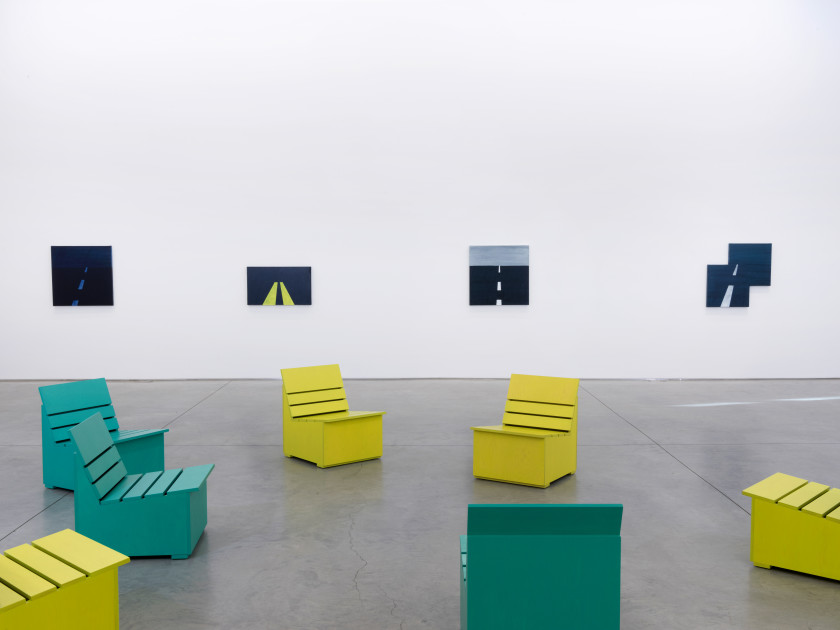Mary Heilman: Every Picture Tells a Story // Profile of the Artist
by Terry R. Myers

Anyone who knows her knows that there is something about Mary Heilmann. There is also something about her work that has provoked no less than four significant survey exhibitions in the past thirteen years: All Tomorrow’s Parties (2003), To Be Someone (2007–09), Good Vibrations (2012–13), and, soon, Looking at Pictures, opening in June 2016 at the Whitechapel Gallery in London. In both cases, this “something” is the same thing—Heilmann is, in her work, a shape shifter and a time traveler. Her abstract paintings, objects, and installations have ways of morphing and being in and out of time all at once that would be fascinating enough if they came across—as they would if they were narratives—as alien, supernatural, or super heroic. And while there is plenty of evidence in terms of influence and devotion to suggest that Heilmann is in fact a superhero in the eyes of many artists, it is the workaday human-ness of her work that has unleashed and grounded its power—to do good—in a pure and playful agility.

The shape shifting aspect of Heilmann’s production is incessantly self-evident from work to work, exhibition to exhibition. Whether standing in front of a single painting, or in a room that features a collection of works (all Heilmann’s or not), it is shape (almost always geometric) and color (almost always vibrant) that remains literally still, yet somehow perpetually in motion. Take, for example, Cup Drawing (1983), a smallish and seemingly unassuming work—with just seven painted segments of coiled and pinched clay that make a kind of “stick figure” cup. It is a work that embodies and emboldens all of the complexities of painting, drawing, and sculpture—not to mention the cyclical relationship of abstraction and representation—all the while setting off a directional energy reminiscent of the lines drawn around an animated cartoon character or the pulses of light that can represent shooting in an old-school video game. And as if these associations weren’t enough, Cup Drawing also tells us a picture story about quieter moments in the life of a cup sitting on a shelf (in the studio, or at a window, or…).

A painting like Maricopa Highway (2014), from one of Heilmann’s more recent (and to my mind most brilliant) series, not only represents a leapfrog jump over her chronology, but also demonstrates the effectiveness of her shape-shifting-upon-shape-shifting that in the past few years she has kicked into high gear. Heilmann exhibited four of the “road” paintings on one wall in her solo exhibition Geometrics: Waves, Roads, Etc. at 303 Gallery in New York at the end of last year. By straightforwardly depicting depth, direction, distance, and duration, all within the familiarity of her formal terrain, these road pictures have brought another layer to the time traveling capabilities of her work. No painter of her generation has held as much simultaneous ground in the past, present and future. This is why her late 1970s pink and black paintings, such as Tomorrow’s Parties, keep resonating over and over: Pachuco style from her 1950s youth in Los Angeles, New Wave from the time of their making, and the perpetual return that fantastic style is almost always guaranteed—all there on the wall, and all at once.
Heilmann has made good use of this sliding square motif since the 1970s: Sliding Square: Green and Gold (1975), Tomorrow’s Parties (1979/1994), Chartreuse (1987), Matisse (1989), Lifeline (1990–94), Renny’s Right Geometry of a Wave (2011), and, finally, Maricopa Highway will play out this history in London. Her recent mash-ups of these squares with disappearing (and lonely) roads do so many things at once that it would seem impossible that these paintings could remain so unapologetically simple, but they do.
Every one of Heilmann’s survey exhibitions has demonstrated that she has been many things at many times and, again, all at once: the late-to-the-party challenger-and-defender-in-chief of Modernism by way of re-engineering it, re-gendering it, replaying (with) it, and re-performing it all as a type of empowering drag. It is, of course, the expansiveness of her agility that has made it work, but that could have gone all self-indulgent and flat if not for a rock-solid conflation of rigor and the everyday. Her singular ability to tell us story after story in pictures of shapes, and shapes of pictures, is what has made Heilmann’s work feminist at its core—but I remain someone who believes that that is a term of expansion rather than limitation. There is, of course, a persuasive counter-argument to be found in, for example, the controlled and intensified work of Gerhard Richter, but I am sure that one of the things I will appreciate the most about this upcoming Whitechapel survey is that it could be the one to bring Heilmann’s argument home.

Terry R. Myers is a critic, independent curator, and Professor of Painting and Drawing at the School of the Art Institute of Chicago. He is a regular contributor to Afterall, ArtReview and The Brooklyn Rail and has contributed essays to numerous exhibition catalogues and books. His recent books include Mary Heilmann: Save the Last Dance for Me (Afterall Books, 2007), and Painting: Documents of Contemporary Art (Whitechapel Gallery and The MIT Press, 2011).